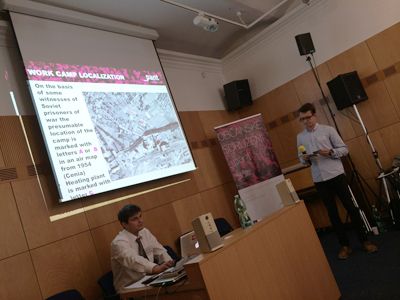Teaching with Testimony Graduate Uses Visual History Archive to Discover Unknown Labor Camp

Mahdal, a teacher at the Gymnazium of Pavel Tigrid in Ostrava-Poruba, Czech Republic, has created lessons using testimonies in the Visual History Archive as part of the Teaching With Testimony professional development program. Along with USC Shoah Foundation’s senior international training consultant Martin Smok, he is also the editor of PANT, a nonprofit educational portal for history teachers in Czech Republic that provides lessons and educational seminars.
In winter 2012 Mahdal and his colleagues at PANT were asked, on behalf of a former prisoner of war named Paolo Complojer, to help locate the camp in Karviná, Czech Republic, where Complojer had been forced to work on a heating plant 66 years ago for nearly two years. The camp was part of the Stalag VIII Teschen, a network of 43 smaller camps in Karviná (“Karwin” in German) with 73,000 prisoners of war who worked in inhumane conditions during World War II. With the help of PANT’s research and air maps from the 1940s, Mahdal and his colleagues were able to locate the camp.
Following the publication of their accomplishment on the PANT website, Mahdal received a request from Hannah Berliner Fishthal, a professor at St. John’s University in Queens, New York, to help locate a forced labor camp for Jews within the Stalag VIII Teschen system called Zwangsarbeit lager für Juden (ZALfJ Karwin). Fishthal was compiling an encyclopedia of camps and ghettos for the United States Holocaust Memorial Museum.
However, almost nothing was known about the existence of such a labor camp for Jews, Mahdal said. Nazis destroyed documentation of the camp at the end of the war, and then the city itself literally disappeared.
“Something we call the loss of landscape memory happened in Karviná,” Mahdal said. “The center of Karviná (today it is called Karviná Doly) almost does not exist now. This place was destroyed by undermining. Nazis and later Communists literally plundered the coal sources. The effect of this was a huge landslide, somewhere around several tens of metres caused by this unreasonable coal mining. Many buildings fell down, some of them had to be pulled down. Old Karviná vanished from the map. New Karviná was built nearby and people were moved to new homes. The roots were pulled out and ruptured.”
There are no references to ZALfJ Karwin in Czech literature, and even local eyewitnesses did not remember it.
ZALfJ Karwin’s existence was proven when Mahdal, aided by the Malach Center for Visual History at Charles University in Prague, discovered 15 testimonies of Jewish survivors in the Visual History Archive

Mahdal turned the research project into an educational opportunity for the students in his history seminar at Gymnazium Pavel Tigrid. Each student was responsible for translating a testimony into Czech.
Mahdal and his students presented their work at a seminar hosted by the USC Shoah Foundation in Ostrava, Czech Republic, in June. Seminar participants were education leaders, NGO representatives and opinion-makers from Poland, Czech Republic, Slovakia and Hungary. The seminar, organized in partnership with PANT, offered participants a unique opportunity to learn first-hand about the effects of using testimony in 21st-century classrooms. It also convened a discussion about how practices across the region can be applied in different localities to address various educational challenges.
Local television media attended the seminar to report on the ZALfJ Karwin project, Smok said, and it was the first time many of the participants realized what USC Shoah Foundation and the Visual History Archive could offer for educators.